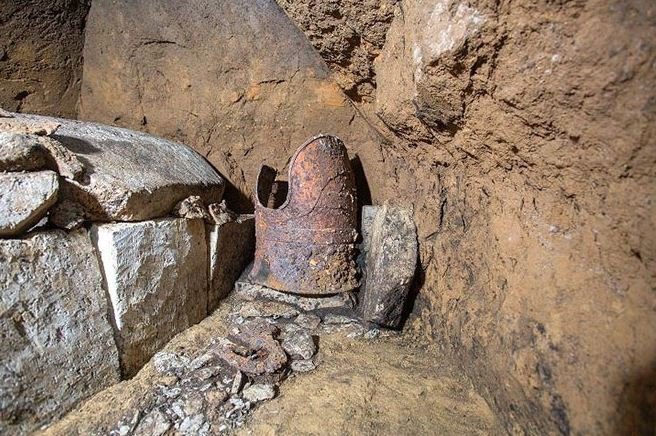Ancient tomb of powerful Japanese chieftain discovered with hoard of weapons
The grave was likely for a "powerful leader" during the Kofun period of Japan.

Ancient Japanese armour in surprisingly good condition has been unexpectedly unearthed alongside human remains at a 1,500-year-old underground tomb, also containing a large stone coffin.
The major find was reported by workers paving a farm road in Shibushi, in the Kagoshima Prefecture of Japan in December. It is now believed that the remains probably belonged to a local chieftain, while the armour, a type of breastplate with connected backplate known as a cuirass, was a gift from the Yamato imperial court in today's Nara Prefecture in appreciation of the leader's cooperation.
Tatsuya Hashimoto, a professor of archaeology at the Kagoshima University Museum, said: "It was likely built for a powerful leader in the local region who was directly connected with the Yamato imperial court," according to Japanese newspaper Asahi Shimbun.
The armour, measuring 35 cm by 40 cm, was in near perfect condition and was found standing up by the coffin, which itself contained a sword, its scabbard and further items. More than 20 burial accessories, such as an iron arrowhead, spear and iron axe, were also found; the tomb contains more grave accessories than any other tunnel-tomb in the Osumi region.
The skeletal remains are those of a 170cm tall adult male. The coffin itself measured 2.4 metres long, 60cm wide and 50cm tall.
The grave is from the Kofun period, which lasted in Japan between approximately 250 to 538 AD and was named after the tomb mounds that were built for members of the ruling class during this time.
The Metropolitan Museum of Art in New York explained: "The practice of building sepulchral mounds and burying treasures with the dead was transmitted to Japan from the Asian continent about the third century A.D. In the late fourth and fifth century, mounds of monumental proportions were built in great numbers, symbolizing the increasingly unified power of the government.
"In the late fifth century, power fell to the Yamato clan, which won control over much of Honshu island and the northern half of Kyushu and eventually established Japan's imperial line."
Burial chambers and sarcophagi in the early tombs were simple and unadorned, before painted decorations began to appear by the sixth century, the museum also said.
Experts said the newly discovered site, named the No. 3 Harada Chikashiki Yokoanabo (Harada underground tunnel-tomb), is one of the largest tunnel-tombs in the Osumi region of eastern Kagoshima Prefecture, comprising a 2.6 metre long vertical shaft and burial chamber. This type of tomb construction is unique to Japan's southern Kyushu region.






















